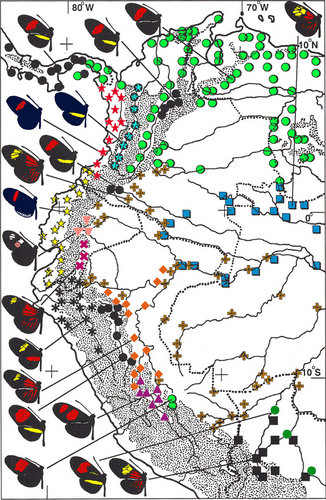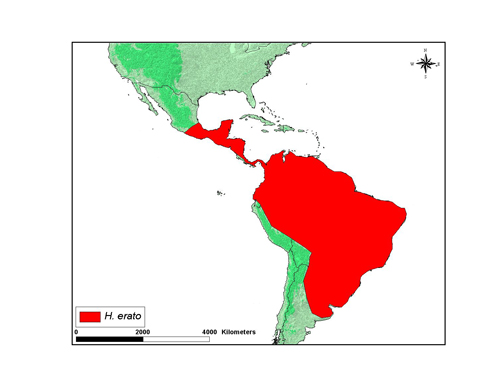Heliconius erato
Margarita Beltrán and Andrew V. Z. BrowerIntroduction
This widespread, geographically variable butterfly (see map 2 below) is involved in Müllerian mimicry with the concordantly variable Heliconius melpomene over most of its range. Only H. erato chestertonii Hewitson does not have a corresponding H. melpomene co-mimic. That race, from the upper Cauca valley of Colombia, is a co-mimic of H. cydno weymeri Staudinger.
Etymology: ERATO was one of the nine Muses, the goddesses of music, song and dance. Her name means "the lovely" or "beloved" from the Greek word eratos. In Classical times, when the Muses were assigned specific artistic spheres, she was named Muse of erotic poetry and mimic imitation and represented holding a lyre (ERATO).
Characteristics
Early stages: Eggs are yellow and approximately 1.5 x 0.9 mm (h x w). Females usually place eggs singly on growing shoots of the host plant. Mature larvae have a white body with black and orange spots, black scoli, and yellow head; length is around 1.3 cm. Caterpillars are solitary (Brown, 1981). Pupae are brown with gold spots on the dorsum, the thorax is strongly bowed and has short abdominal spines. The head has long head horns and the antennae have many short black spines (Brown, 1981; DeVries, 1997).
Geographical Distribution
Heliconius erato is widespread throughout Central America and South America. The map below shows an approximate representation of the geographic distribution of this species. The original data used to draw these maps are derived from Brown (1979) which is available at Keith S. Brown Jr. (1979). Ecological Geography and Evolution in Neotropical Forests.
Habits
H. erato occurs from sea level to 2,300 m in forest edges. Usually individuals fly erratically and in the lowerstory. The males sit on female pupae a day before emergence, and mating occurs the next morning, before the female has completely eclosed. Adults roost at night in small groups 2-10 m above ground in twigs or tendrils (Brown, 1981).
Host plant: H. erato larvae feed primarily on plants from the subgenera Granadilla, Tryphostemmatoides, and Plectostemma (Passifloraceae) (Brown et al., 1977). In Costa Rica H. e. petiverana feeds on Passiflora talamancensis, P. coreacea, and P. biflora (DeVries, 1997).
Geographical Races


Distribution of Heliconius erato geographical races of Central America and the trans-Andean and the upper Amazonian regions of South America, and the closely-related H. himera (black asterisks). Symbols indicate distinct phenotypes, but some phenotypes, such as those indicated by the black and green circles, represent multiple allopatric races. Wing patterns of geographical races of H. erato are relatively uniform throughout their ranges, except where they overlap with adjacent races. In these regions, they freely hybridize, producing a hyperdiverse array of F2 and F1 backcross wing pattern phenotypes. Stippled areas of the map indicate mountainous regions uninhabited by H. erato. Figure modified from Mallet (1993), © 2007 Andrew V. Z. Brower.
Helicoinus erato races illustrated include:
- Heliconius erato petiverana Doubleday, 1847, Mexico to central Panama (black circles)
- Heliconius erato hydara Hewitson, 1867, eastern Panama to Guianas (light green circles; may represent multiple distinct races)
- Heliconius erato guarica Reakirt, 1868, Magdalena Valley, Colombia (light green circles)
- Heliconius erato demophoon Ménétriés, 1855, eastern slope of Cordillera Oriental, Colombia (black circles)
- Heliconius erato dignus Stichel, 1923, Río Putumayo, Colombia (black circles)
- Heliconius erato chestertonii Hewitson, 1872, upper Cauca Valley, Colombia (light blue stars)
- Heliconius erato venus Staudinger, 1882, Chocó, Colombia (red stars)
- Heliconius erato cyrbia Godart, 1819, western Ecuador (yellow stars)
- Heliconius erato erato (L., 1758)/H. erato amazona Staudinger, 1897/H. erato amalfreda Riffarth, 1901, Amazonia (blue squares)
- Heliconius erato notabilis Salvin & Godman, 1868, Napo, Ecuador (pink inverted triangles)
- Heliconius erato etylus Salvin, 1871, Pastaza, Ecuador (magenta Xs)
- Heliconius erato lativitta Butler, 1877, upper Amazonia (gold crosses)
- Heliconius erato emma Riffarth, 1901, northeastern Peru (orange diamonds)
- Heliconius erato venustus Salvin, 1871, Bolivia (black squares)
- Heliconius erato favorinus Hoppfer, 1874, Río Marañon, Peru (black circles)
- Heliconius erato microclea Kaye, 1907, Río Chanchamayo, Peru (purple triangles)
- Heliconius erato amphitrite Riffarth, 1901, southeastern Peru (light green circles)
- Heliconius erato phyllis Fabricius, 1775) eastern Bolivia to SE Brazil (dark green circles)
References
Brower AVZ. 1994. Rapid morphological radiation and convergence among races of the butterfly Heliconius erato inferred from patterns of mitochondrial DNA evolution. Proc. Natl. Acad. Sci. USA 91: 6491-6495.
Brower AVZ. 1996. Parallel race formation and the evolution of mimicry in Heliconius butterflies: a phylogenetic hypothesis from mitochondrial DNA sequences. Evolution 50: 195-221.
Brown, K. S., Jr. 1979 Ecologia Geográfica e Evolução nas Florestas Neotropicais. Campinas, São Paulo, Brasil: Universidade Estadual de Campinas.
Brown K. S. 1981 The Biology of Heliconius and Related Genera. Annual Review of Entomology 26, 427-456.
Descimon, H. & Mast de Maeght, J. 1983 Semispecies relationships between Heliconius erato cyrbia Godt. and H. himera Hew. in southwestern Ecuador. J. Res. Lep. 22, 229-237.
DeVries P. J. 1997 The Butterflies of Costa Rica and Their Natural History, Volume I: Papilionidae, Pieridae, Nymphalidae Princeton University Press, Baskerville, USA.
ERATO. Theoi Greek Mythology. http://www.theoi.com/Ouranios/MousaErato.html [Accessed Jul 23, 2008].
Jiggins, C. D., McMillan, W. O., King, P. & Mallet, J. 1997 The maintenance of species differences across a Heliconius hybrid zone. Heredity 79, 495-505.
Mallet, J. 1993. Speciation, raciation and color pattern evolution in Heliconius butterflies: evidence from hybrid zones. In Hybrid Zones and the Evolutionary Process (ed. R. G. Harrison), pp. 226-260. Oxford: Oxford University Press.
Linnaeus C., 1758. Systema naturae per regna tria naturae, secundum classes, ordines, genera, species, cum characteribus, differentiis, synomymis, locis. Editio Decima, reformata. Holmiae, Laurentius Salvius. 1: iv + 823 + [1] pp. ([1 January]) [facsimilar reprint in Mid-Continent Lepidoptera Series 2(23), April 1971]
Sheppard, P. M., Turner, J. R. G., Brown, K. S., Benson, W. W. & Singer, M. C. 1985 Genetics and the evolution of Muellerian mimicry in Heliconius butterflies. Phil. Trans. R. Soc. Lond. B 308, 433-613.
Title Illustrations

| Scientific Name | Heliconius erato emma |
|---|---|
| Specimen Condition | Dead Specimen |
| View | Dorsal |
| Collection | Gerardo Lamas |
| Image Use |
 This media file is licensed under the Creative Commons Attribution-NonCommercial-ShareAlike License - Version 3.0. This media file is licensed under the Creative Commons Attribution-NonCommercial-ShareAlike License - Version 3.0.
|
| Copyright |
©

|
| Scientific Name | Heliconius erato emma |
|---|---|
| Specimen Condition | Dead Specimen |
| View | Ventral |
| Collection | Gerardo Lamas |
| Image Use |
 This media file is licensed under the Creative Commons Attribution-NonCommercial-ShareAlike License - Version 3.0. This media file is licensed under the Creative Commons Attribution-NonCommercial-ShareAlike License - Version 3.0.
|
| Copyright |
©

|
| Scientific Name | Heliconius erato favorinus |
|---|---|
| Specimen Condition | Dead Specimen |
| View | Dorsal |
| Collection | Gerardo Lamas |
| Image Use |
 This media file is licensed under the Creative Commons Attribution-NonCommercial-ShareAlike License - Version 3.0. This media file is licensed under the Creative Commons Attribution-NonCommercial-ShareAlike License - Version 3.0.
|
| Copyright |
©

|
| Scientific Name | Heliconius erato favorinus |
|---|---|
| Specimen Condition | Dead Specimen |
| View | Ventral |
| Collection | Gerardo Lamas |
| Image Use |
 This media file is licensed under the Creative Commons Attribution-NonCommercial-ShareAlike License - Version 3.0. This media file is licensed under the Creative Commons Attribution-NonCommercial-ShareAlike License - Version 3.0.
|
| Copyright |
©

|
About This Page

University of Cambridge, Cambridge, UK

Middle Tennessee State University, Murfreesboro, Tennessee, USA
Correspondence regarding this page should be directed to Margarita Beltrán at and Andrew V. Z. Brower at
Page copyright © 2010 and
 Page: Tree of Life
Heliconius erato .
Authored by
Margarita Beltrán and Andrew V. Z. Brower.
The TEXT of this page is licensed under the
Creative Commons Attribution-NonCommercial-ShareAlike License - Version 3.0. Note that images and other media
featured on this page are each governed by their own license, and they may or may not be available
for reuse. Click on an image or a media link to access the media data window, which provides the
relevant licensing information. For the general terms and conditions of ToL material reuse and
redistribution, please see the Tree of Life Copyright
Policies.
Page: Tree of Life
Heliconius erato .
Authored by
Margarita Beltrán and Andrew V. Z. Brower.
The TEXT of this page is licensed under the
Creative Commons Attribution-NonCommercial-ShareAlike License - Version 3.0. Note that images and other media
featured on this page are each governed by their own license, and they may or may not be available
for reuse. Click on an image or a media link to access the media data window, which provides the
relevant licensing information. For the general terms and conditions of ToL material reuse and
redistribution, please see the Tree of Life Copyright
Policies.
- First online 18 February 2007
- Content changed 12 August 2008
Citing this page:
Beltrán, Margarita and Andrew V. Z. Brower. 2008. Heliconius erato . Version 12 August 2008 (under construction). http://tolweb.org/Heliconius_erato/72242/2008.08.12 in The Tree of Life Web Project, http://tolweb.org/







 Go to quick links
Go to quick search
Go to navigation for this section of the ToL site
Go to detailed links for the ToL site
Go to quick links
Go to quick search
Go to navigation for this section of the ToL site
Go to detailed links for the ToL site